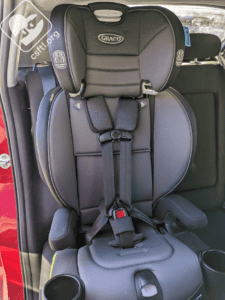I can instantly make you a better driver

Imagine this: You’re cruising along on a three-lane highway. The speed limit is 70. You’re in the middle lane and you’re closing the gap to the car in front of you. There’s slower traffic to your right and a clear lane to the left. You signal and start moving into the passing lane, but halfway there, you spot a cop in the median, clearly hunting speeders. What do you do?
“Do you know how fast you were going?”
That rarely ends well. If you’re hearing it, you’re on the side of the road, mirrors reflecting blue and red — and perhaps a spotlight. Maybe you’ll talk your way out of it and maybe you won’t. But the question looms large, right up there with, “Do you know where your kids are?” It’s loaded. “Yes” means you know you were speeding. “No” is tempting; ignorance always feels better than admitting guilt, right?
But what’s frightening is just how many drivers truly have no clue. I don’t have stats and I don’t need them. We all see it play out every time we hit the road: drivers holding up traffic in the passing lane, slamming on the brakes for speed traps and cutting people off — all because they’re unapologetically unaware of their own pace of travel. Neither driving fast nor driving slow automatically makes somebody a bad driver, but not knowing where you land on that spectrum at any given time makes you little more than a rolling safety hazard.
This critical variable informs everything else we do behind the wheel, and leaving it out of your mental calculations means that every action you’re performing is based on unreliable information. The data science shorthand is GIGO, for “garbage in, garbage out.” Observe traffic long enough and you’ll spot countless people driving like, well, garbage.
Take out the trash
This danger is easily remedied: All you need to do is know how fast you’re going. That’s it, my one-step plan. The resources to do it are already right in front of you, and it will cost you nothing — not even time. But knowing this critical bit of information will improve every decision you make behind the wheel.
Let’s revisit the scenario from above. You’re in the middle lane and gaining on traffic, the speed limit is 70, and you have the opportunity to pass. But this time, you know for a fact you’re already doing 74. Does knowing your speed alter your guilt in this scenario? No, but it allows you to make an informed decision rather than relying on guesswork— or worse, blindly panic-braking when you see the cop, which is an incredibly dangerous thing to do at speed. If I were to make a split-second judgment call in this scenario, I’d roll the dice on 74 in a 70 and complete the pass as if the cop wasn’t even there.
Yes, that’s me openly acknowledging that I’d flagrantly violate the law in the presence of a police officer. Is that the smartest thing in the world? No, but consistent and predictable behavior is the topsoil from which good traffic flow naturally sprouts. By committing to my maneuver and maintaining speed, I’m one less obstacle for others, plus I’m contributing positively to the flow by not slowing down while completing a pass — something many drivers are guilty of even without an overt threat of intervention from law enforcement. Of course, another choice would be to simply ease back to the limit and not execute the pass in the first place.
Use your cruise
Let’s look at this another way: Every piece of critical information you know is one less that you have to acquire, calculate or outright guess. The advantages are convenient under the best of circumstances and potentially life-saving under the worst, and all you need to do is keep tabs on the one piece of information cars are universally required to provide. But even if you can’t be bothered, your car is likely built with advanced technology that will help.
Yes, by “advanced technology,” I mean cruise control — a feature found on pretty much anything nicer than a Little Tikes Cozy Coupe. How better to know how fast you’re going than by dictating that speed yourself? Cruise has been around in some form or another since the 1950s, and despite its ability to reduce mental and physical fatigue and smooth out traffic, it remains criminally underutilized.
I’ll be the first to admit that a bad cruise control (adaptive or otherwise) system can betray you. Wild speed variations on grades and other odd behavior can be maddening to the fastidious driver, but even a bad system can do some good with a little human intervention. If your car struggles going up hills, don’t pass on them. If it runs away on the descent, shift down a gear or two to bring compression braking into the mix. Learn the quirks so they become predictable, and compensating either becomes unnecessary or second-nature.
Your journey is just beginning
I saved this bit for last. Think of it as a post-credits scene in a superhero film. Attention is a gateway driving skill. We are organic computers trying to tell a ton or more of machinery what to do. Like any other processor, the human mind has finite bandwidth. Remember what I said above: Every piece of critical information you know is one less that you have to acquire, calculate or outright guess. Every input you can safely ignore frees up bandwidth for the things you have no choice but to process in real time — whether that be a fellow driver losing control on the racetrack or a cop appearing in the median.
In time, awareness will seamlessly integrate with muscle memory. You’ll learn how your car feels taking a curve at any given speed, start to anticipate the weight shift and unconsciously adjust your line to smooth it out. You’ll find yourself naturally looking farther ahead because you know your situation without looking down. Maybe next time, you’ll see that trooper in the median much sooner because your eyes were up, seeking new information. Maybe you give a pleasant wave as you pass, and nobody in that cruiser can hear you say, “Spotted you two exits back, sucker.”
Because you knew how fast you were going. And nobody had to pull you over and ask.
Related Video





